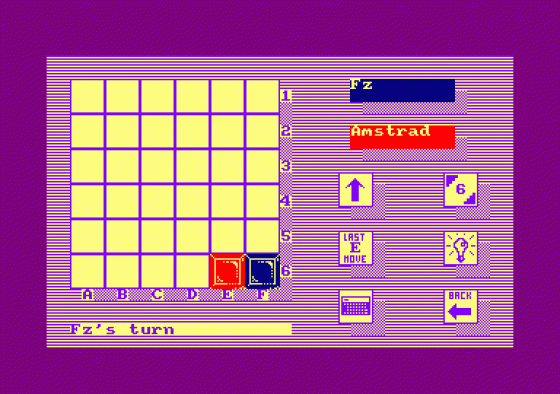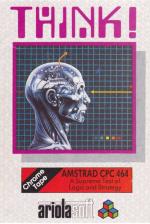
Amstrad Action
 1st March 1986
1st March 1986
Categories: Review: Software
Publisher: Ariolasoft
Machine: Amstrad CPC464
Published in Amstrad Action #6
Think!
Let's get the predictable bit over with first - yes, it does make you think. This sort of puzzle game has been noticeable by its absence on the Amstrad, but anyone looking for a mental challenge that doesn't involve arcade adventuring - just logic and analysis - will be more than happy.
The rules of the game are very simple but, as with games like Othello and Chess, learning the rules is the easy part, discovering the tactics and strategies is another. The game takes place on a 6 x 6 grid onto which counters can be pushed by the two players. The counters can be pushed on from the right hand or bottom edges of the grid and when they are the row or column they're pushed into moves along one square.
The aim is to get four counters in a line horizontally, vertically or diagonally before your opponent. He can be the computer on one of seven difficulty levels or a human opponent against whom several different types of game can be played. The computer opponent plays a good game on all seven levels of play, taking a long time to move on 5-7 but playing fast and well on level four in particular.

The player can take as long as he likes to move against the computer and against such a logical silicon mind that time is needed to analyse all the possible moves. The early decisions are easy but once five or six counters are on the board things start to get very complicated. It's practically impossible to fill the whole board with counters without somebody winning but even if you should manage it play continues because counters just disappear off the top and left of the grid when pushed off.
The game selections before and during the game are made using single keystrokes and icons. There are plenty of options that will allow you to change the program in many ways. The most important is the two player option where the players can have special games of speed and blitz think. Speed think sets a time limit on each individual move, exceeding which forfeits that move, and blitz think sets a limit for the whole game and if either player's runs out they lose the game.
There are also tutorial and solve games in which the computer teaches you the game by marking your moves in a game or sets you problems to solve respectively. Tutorial is annoying in the extreme since it doesn't always let you play the best move - computers don't always know best. The problems are more fun, all six of them can be solved in two moves by player one but finding the solution can be quite tough.

There are lots of other options available. On the main menu, you can change the counter colours or have a green screen setting, put the sound on or off and load or save the game. Both main displays are attractively presented by the sound is a single beep which is best turned off.
The options within the game are more interesting and allow you to indulge in some underhand tactics. There are level and last move indicators, the former of which can be changed and the latter used in long games where you've got time to make the tea to check up on what the computer's been up to. There's a function where the computer will suggest the next move for you and one where you can force the computer to play the next move. The nicest option is the one where you can take the game back two moves at a time if a losing situation looks like coming up.
When the game is won or lost, a replay of all the moves can be shown and a quick analysis made of where you went wrong or right. You can even use the solve option to set up a position for analysis or to challenge another human player to crack it.
It's a well presented game with plenty of options and of course endless variation in the games that can be played. Its only flaw is in the lack of a scoring system for the contests but many happy hours will be spent sliding counters even if the tally has to be kept on paper.
Second Opinion
A very impressive piece of work. In fact, it's the first board game I've ever seen on a computer - any computer - which plays better on the machine than the living room table. It's easy to get into, but gets very difficult on higher levels. And the speed option is nerve-wracking. The pleasant display and the numerous options available make it a game that you're bound to play again and again.
Good News
P. Very easy to pick up.
P. Lots of logical and analytical thought required.
P. Plenty of options to maintain interest.
P. Speed and blitz games add a new dimension to the action.
P. Two player games can be quite a battle of wits.
Bad News
N. Pathetic sound.
N. No scoring system except in the annoying tutorial mode.



